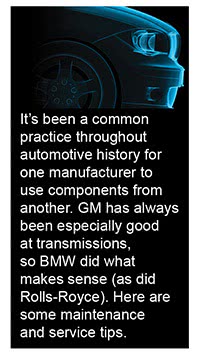 Since 1991, BMW has installed the General Motors THM-R1 transmission in the 3- and 5-Series. As the relationship between GM’s French division (Hydramatic) and BMW grew, so did the number of gears in the new transmission. While the new six-speeds are on the way, here are some things we need to watch out for while servicing the four- and five-speeds units.
Since 1991, BMW has installed the General Motors THM-R1 transmission in the 3- and 5-Series. As the relationship between GM’s French division (Hydramatic) and BMW grew, so did the number of gears in the new transmission. While the new six-speeds are on the way, here are some things we need to watch out for while servicing the four- and five-speeds units.
I.D. is the Key
To properly service any transmission, we’d better know who manufactured it. BMW has used three suppliers. Its manual transmissions are made by Getrag
and Zahnradfabrik Friedrichshafen (ZF). General Motors and ZF produce its automatic transmissions. With more than one manufacturer in the picture, BMW decided to come up with its own system of identification in order to make it easier to organize service information, as well as for ordering parts. So, the THM-R1 was changed to the A4S 270/310R. These two versions had different torque capability ratings, either 270Nm or 310Nm depending on which car it was installed in. What was the point of the change between the two identification numbers? BMW developed a numbering system that would indicate the number of gears, torque limit, and, of course, the manufacturer. The identification tag is found on the driver’s side of the trans.
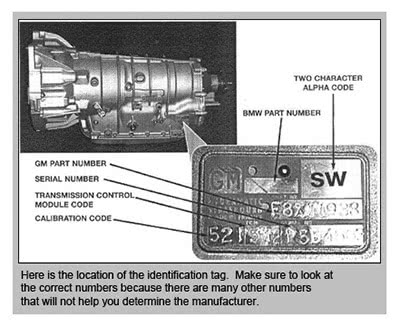
ÂThere’s more information on the tag than just the identification, so be sure to look in the right spot for the BMW ID number. The first letter indicates if it’s an automatic or a manual, the second number is how many gears it has, and the third letter indicates if top gear is overdrive or not. The next group of numbers indicates its maximum torque rating. The last digit tells us the manufacturer. An example would be the A5S 360R. This alpha/numeric designation means it’s an automatic transmission with five gears (including overdrive), it can handle up to 360Nm of torque, and it’s manufactured by GM — that’s what the “R†refers to. If it were a “Z,†that would indicate a ZF.
In GM-speak, the BMW A5S 360R is referred to as a 5 L40-E. This won’t be useful in ordering parts from BMW, but, on the flip side, if you have a hard time getting what you need you could access your usual supply chains using the GM designation. Traditionally the 3-Series and the 5-Series/X5 with the six-cylinder engines received the GM transplant. The larger chassis and engine combinations were mated with the ZF unit. Now that we know what we’re working on, let’s see what services we can perform.
On-Car
There are two categories, maintenance and repair. For the first, the A4S 270/310R uses Dexron III fluid, and it has been considered “lifetime†since 1996. So, there’s no specificied service interval for replacing it. But, as stated in the March, ‘07 issue of MT, every 30,000 miles is recommended by many authorities, regardless of the make. Since BMW started off with the fill-for-life†idea for the GM5, it’s open to interpretation, but we can all agree that environment, vehicle loads and customers’ driving habits can accelerate the deterioration of ATF.
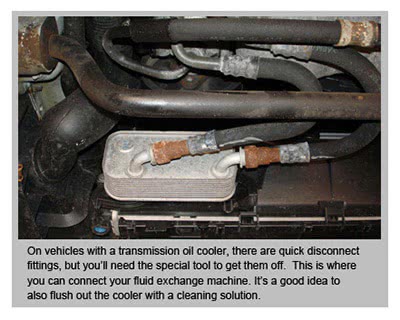 One service we can provide our customers is replacing the filter and pan gasket. When doing this traditional job, however, only about 1/3 to 1/2 of the ATF is actually drained. The screen element only prevents large debris from recirculating back through the pump and valve body. By the way, be careful that the screen seal doesn’t stay stuck up in the valve body when you install the new one. A relatively new service we can perform is a fluid exchange, commonly know as trans flushing, which requires a machine and is usually done with the engine running. On most cars, you tap into the cooler lines at the radiator. Newer BMWs with the GM5 have separate transmission fluid coolers to link up with. With the lines connected and the engine idling, you allow the old transmission fluid to be pumped out while you feed new fluid into the return line. This ensures that up to 95% of the ATF is replaced, even the fluid trapped in the upper housing and valve body. Fluid flushing does not require that we match the BMW fluid requirements since we’re not mixing different types. Unless the transmission is under factory warranty, there are other options as far as synthetic transmission fluids are concerned that will work. If the vehicle is under warranty, however, and the customer still wants the fluid changed you will have to get the specified ATF from a BMW dealer in order to comply with the warranty requirements.
One service we can provide our customers is replacing the filter and pan gasket. When doing this traditional job, however, only about 1/3 to 1/2 of the ATF is actually drained. The screen element only prevents large debris from recirculating back through the pump and valve body. By the way, be careful that the screen seal doesn’t stay stuck up in the valve body when you install the new one. A relatively new service we can perform is a fluid exchange, commonly know as trans flushing, which requires a machine and is usually done with the engine running. On most cars, you tap into the cooler lines at the radiator. Newer BMWs with the GM5 have separate transmission fluid coolers to link up with. With the lines connected and the engine idling, you allow the old transmission fluid to be pumped out while you feed new fluid into the return line. This ensures that up to 95% of the ATF is replaced, even the fluid trapped in the upper housing and valve body. Fluid flushing does not require that we match the BMW fluid requirements since we’re not mixing different types. Unless the transmission is under factory warranty, there are other options as far as synthetic transmission fluids are concerned that will work. If the vehicle is under warranty, however, and the customer still wants the fluid changed you will have to get the specified ATF from a BMW dealer in order to comply with the warranty requirements.
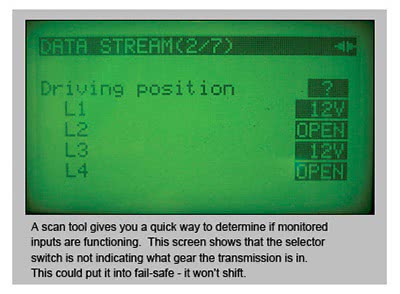 Keep in mind when performing fluid exchanges that the old ATF has clutch and bearing material in it. Since this has been removed from the valve body, it may have taken care of some sticking valves and solenoids, thus improving shifting. On the other hand, the clutch plates are now worn — new friction material did not miraculously attach itself to the plates — and flushing is not a rebuild. So, while a fluid flush may extend the useful life of the transmission and improve shifting, at some point the unit will need an overhaul. You don’t want customers to think they’re guaranteed to get another 100,000 miles out of the transmission because of a fluid exchange. Always keep in mind, “My customer (or my girl friend) may be a lawyer, and everything I say can and will be used against me in a court of law.â€
Keep in mind when performing fluid exchanges that the old ATF has clutch and bearing material in it. Since this has been removed from the valve body, it may have taken care of some sticking valves and solenoids, thus improving shifting. On the other hand, the clutch plates are now worn — new friction material did not miraculously attach itself to the plates — and flushing is not a rebuild. So, while a fluid flush may extend the useful life of the transmission and improve shifting, at some point the unit will need an overhaul. You don’t want customers to think they’re guaranteed to get another 100,000 miles out of the transmission because of a fluid exchange. Always keep in mind, “My customer (or my girl friend) may be a lawyer, and everything I say can and will be used against me in a court of law.â€
 When diagnosing any transmission-related problem, checking codes is always a good place to start. One of the biggest challenges with any shifting issue is isolating the trouble in either mechanical or electronic controls. BMWs can set a transmission code and not turn on the MIL. Of course, any codes may give you a starting point for the diagnosis. If there are no codes, lean toward a mechanical failure and start testing there. BMW does not give much in the way of mechanical testing. Main line pressure should be between 136 and 152psi.
When diagnosing any transmission-related problem, checking codes is always a good place to start. One of the biggest challenges with any shifting issue is isolating the trouble in either mechanical or electronic controls. BMWs can set a transmission code and not turn on the MIL. Of course, any codes may give you a starting point for the diagnosis. If there are no codes, lean toward a mechanical failure and start testing there. BMW does not give much in the way of mechanical testing. Main line pressure should be between 136 and 152psi.
A scan tool will give you a decent amount of data to use in checking the transmission control unit inputs and solenoid controlled outputs. Look at the inputs and you may find some unusual data. If the gear position indicator in the instrument cluster doesn’t indicate a gear, start testing the gear selector switch. Fortunately, many repairs can be performed with the transmission in the vehicle. After removing the pan and pulling the screen, you can R&R the valve body. Even without removing the valve body, you can still service other items such as the pressure control solenoid, TCC pressure regulator, shift solenoids and harness. Some of these procedures require that you remove the shift mechanism, but that’s still better than having to pull the transmission. Also, if you drop the driveshaft you can do the rear seal, but these units tend to have more problems with the front seal. TSB # 24 02 02 tells us about a kit for installing an updated front seal to prevent leaks and poor shifting.
The Fluid Problem
One service procedure that falls into both the maintenance and repair categories is fluid level checking. You may think this is strictly a maintenance issue, but you’d be surprised to find out how many shifting problems are repaired by simply topping off a low fluid level. For the four-speed transmission this is not a problem. An Orange sticker on the pan tells us to use Dexron III.
For vehicles manufactured after ’98, however, this may be a problem because BMW has used special fluid in its five-speed transmissions. “Topping off†with the wrong ATF could create more problems than it does good. If you’re just going to top off, you have to be careful and read the sticker on the bottom of the pan. When refilling these GM5 transmissions, you’re either going to add Texaco ETL-7045E (Texamatic 7045E — yellow sticker), or, on later production vehicles, Texaco ETL-8072B, which is indicated by a green sticker. Depending on the dealer in your area, you may not be able to purchase small amounts. Instead, you have to purchase 25-liter containers, or ship the vehicle off to the new-car dealer.
Valvoline suggests that its Maxlife transmission fluid it an acceptable replacement for the ETL-7045E or the -8072B, and, in a recent development, BMW has approved a synthetic Mobil transmission fluid designated SHC 630. If you’re only going to top off the level, don’t mix fluids. Once again, if you’re going to use an alternative ATF, you should perform a complete fluid exchange.
And Now the Level-Checking Procedure…
BMW has published technical service bulletin SI B 24 01 98 on the proper procedure for checking the fluid level. Number One: The transmission fluid must be between 30 to 50 deg. C (86 to 122 deg. F.). If you have BMW software on your scan tool, you should be able to pull up this PID in data.
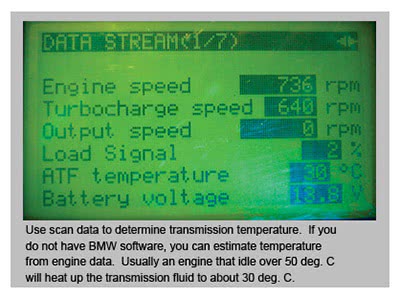 The next step is to start the engine and leave it running. Also, turn on the air conditioning to boost idle speed. This will insure that all of the passages are filled with fluid. If the A/C isn’t working, any means of increasing idle speed is acceptable. Once the fluid is up to temperature you should step on the brakes and slowly shift the transmission through all of its gears. This ensures fluid has passed through all of the channels of the valve body. You will want to apply the parking brake as an added safety measure. If the car’s on a chassis lift, don’t let the wheels spin because you may set ABS and/or DSC (traction control) codes. Another reason to avoid wheel spinning is that the CV joints can be damaged by the sharp angle created by hanging wheels. Finally, remove the fill port cap of the transmission. If the fluid level is correct, you should see a small stream of fluid coming from the port. If no fluid is flowing, the level is too low. You should add ATF through the fill port until it starts to drip out.
The next step is to start the engine and leave it running. Also, turn on the air conditioning to boost idle speed. This will insure that all of the passages are filled with fluid. If the A/C isn’t working, any means of increasing idle speed is acceptable. Once the fluid is up to temperature you should step on the brakes and slowly shift the transmission through all of its gears. This ensures fluid has passed through all of the channels of the valve body. You will want to apply the parking brake as an added safety measure. If the car’s on a chassis lift, don’t let the wheels spin because you may set ABS and/or DSC (traction control) codes. Another reason to avoid wheel spinning is that the CV joints can be damaged by the sharp angle created by hanging wheels. Finally, remove the fill port cap of the transmission. If the fluid level is correct, you should see a small stream of fluid coming from the port. If no fluid is flowing, the level is too low. You should add ATF through the fill port until it starts to drip out.
Keep in mind that the vehicle needs to be level. It’s likely you will be performing the fluid level check with the vehicle up on a lift, and you may have to adjust the height of the perches of your lift. Use any kind of level gauge on the body to make sure.
We hope the next time you see one of these the job goes a little bit easier. Informing customers about the cost of special transmission fluids and their availability will allow them to make an informed decision and trust that you’re looking out for their best interests. We can’t think of a better way to keep customers coming back.
by Kerry Jonsson





0 Comments